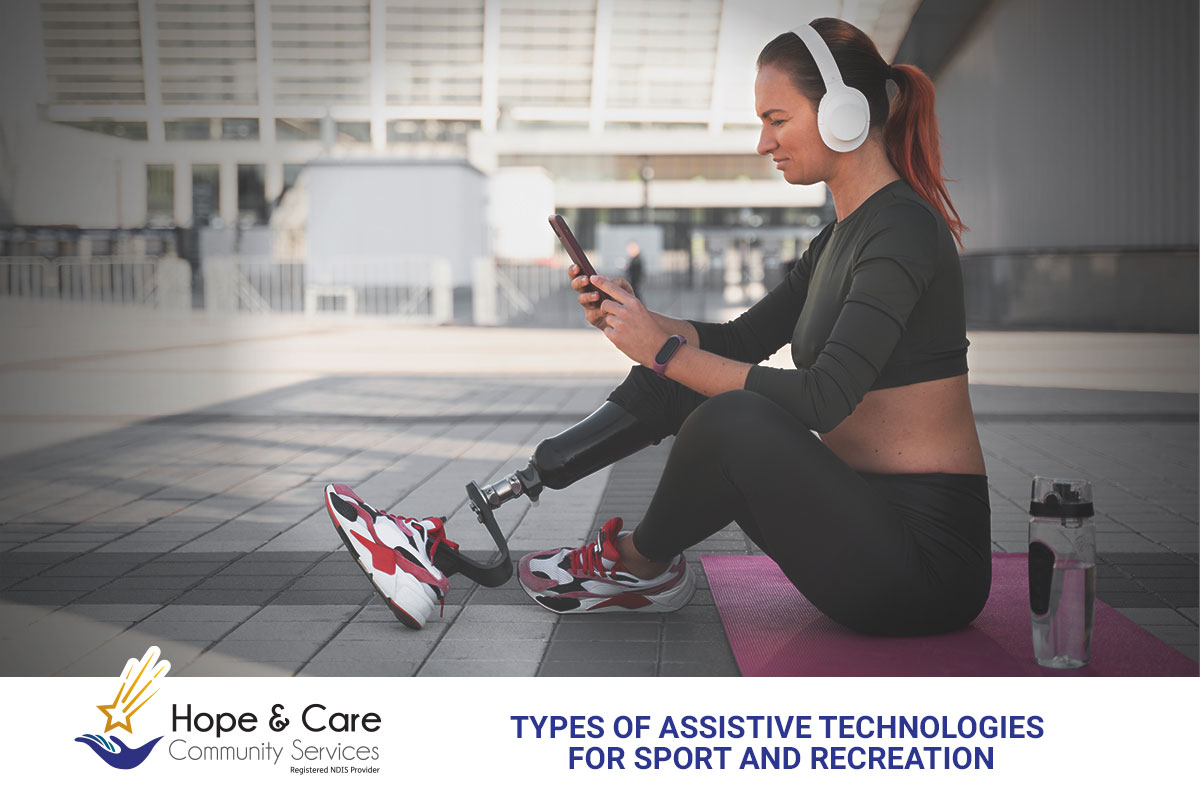
Participating in sports and recreational activities is essential for improving physical health, boosting mental well-being and fostering social connections. For individuals with disabilities, Assistive Technology (AT) provides the tools needed to engage in these activities confidently and effectively. In fact, many of these tools fall under the category of assistive technologies for sport and recreation, designed to break down barriers and promote inclusion.
At Hope & Care Community Services, we believe everyone should have access to the benefits of sports and recreation. That’s why we focus on providing assistive technologies for sport and recreation,” enabling individuals to participate fully and excel in their chosen activities. This guide explores the various types of assistive technologies that empower individuals of all abilities to enjoy and succeed in physical pursuits.
What Is Assistive Technology in Sports?
Assistive Technology refers to devices and systems designed to improve functionality and overcome barriers. These assistive technologies for sport and recreation help individuals with disabilities perform tasks safely and effectively, ensuring inclusivity and promoting independence in athletic and leisure settings.
These technologies range from adaptive sports equipment to communication aids, opening up a world of opportunities for individuals of all abilities.
Does the NDIS Fund Assistive Technology for Sports?
Yes, the National Disability Insurance Scheme (NDIS) provides funding for assistive technologies that align with your personal goals. If participating in sports and recreation is part of your NDIS plan, you may receive funding for equipment like adaptive wheelchairs or prosthetics.
It is important to include these goals in your NDIS plan and understand that while specialised equipment may be covered, general expenses like club memberships or uniforms typically are not.
Top Assistive Technologies for Sport and Recreation
Assistive technologies vary widely based on the type of activity and the specific needs of individuals. Here are some of the most impactful options available:
Orthotics
Orthotics are devices that support and align the body to improve movement and reduce the risk of injury. In sports, orthotics enhance mobility, allowing individuals to participate in activities with greater ease.
- Examples include:
- Ankle-foot orthoses (AFOs) for better walking or running stability.
- Wrist splints to protect against strain during repetitive motion sports.
Regular maintenance is key to ensuring orthotics remain effective and comfortable.
Prosthetics
Prosthetics are artificial limbs designed to restore mobility and functionality. For athletes, sport-specific prosthetics can significantly enhance performance and comfort.
- Examples include:
- Lower-limb prosthetics for running, cycling, or swimming.
- Upper-limb prosthetics with attachments for sports like archery or rowing.
These technologies allow individuals to participate in activities that might otherwise be inaccessible, empowering them to reach their full potential.
Adaptive Sports Equipment
Adaptive sports equipment refers to modified or specially designed gear that accommodates the needs of individuals with disabilities. This equipment makes it possible to engage in a wide variety of sports.
- Examples include:
- Sports wheelchairs for basketball, tennis, or racing.
- Hand cycles for individuals who cannot use traditional bicycles.
- Sit-skis for navigating slopes in winter sports.
Adaptive equipment has transformed the world of sports, providing greater access and inclusivity.
Sensory Assistive Devices
Sensory devices cater to individuals with visual or hearing impairments, enabling them to participate in sports and recreational activities.
- Examples include:
- Audio beacons that guide players in sports like goal ball.
- Vibrating timers to signal race starts for swimmers with hearing impairments.
- Tactile maps that help visually impaired individuals navigate sports facilities.
These devices ensure that sensory impairments do not limit access to the joy of sports.
Communication Devices
Communication is critical in team sports and coaching. Assistive communication devices allow individuals with speech or hearing impairments to interact effectively with teammates and coaches.
- Examples include:
- Speech Generating Devices (SGDs) for conveying instructions or strategies.
- Sign language interpreting gloves that translate signs into spoken words.
- Augmentative and Alternative Communication (AAC) apps for seamless interaction during games.
These devices promote collaboration and ensure everyone is part of the team.
How to Choose the Right Assistive Technology
Selecting the right assistive technology is essential for safety, performance and enjoyment. Consider these steps when making your decision:
Assess Your Needs: Work with healthcare professionals to identify the most suitable options based on your abilities and goals.
Try Before You Buy: Whenever possible, test the equipment to ensure it meets your needs and preferences.
Learn Proper Usage: Understand how to use the equipment correctly to maximise its benefits.
Maintain the Equipment: Regular cleaning and servicing will ensure durability and safety.
Hope & Care Community Services can help guide you in choosing and using the right assistive technologies for sport and recreation to enhance your sports and recreational experiences.
Why Assistive Technology Matters
Assistive technologies enable individuals with disabilities to engage fully in sports and recreational activities. They enhance physical health, improve mental well-being and build social connections.
By overcoming barriers to participation, Assistive technologies for sport and recreation promote inclusivity and empower individuals to achieve their goals—whether it is competing in adaptive sports or enjoying recreational activities with friends.
Conclusion
Assistive technologies have revolutionised the way individuals with disabilities experience sports and recreation. From orthotics and prosthetics to sensory devices and communication aids, these tools ensure that everyone has the opportunity to stay active and connected.
At Hope & Care Community Services, we are dedicated to supporting you in finding the right technologies to meet your needs and achieve your goals. Let us work together to make sports and recreation accessible to all.
Want to learn more? Read other articles :
- Redefine Independence your own way – with HCCS
- Who’s Who: The Key Terms of Your NDIS Plan
- Foundational Supports: Building Blocks of NDIS Success
HCCS is a registered NDIS provider. Learn more about our services.
♥ We are available in Brisbane! – Our team is just a call away!
